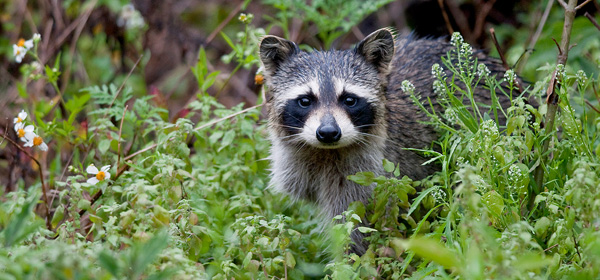 story by Bernard BrownThe fat raccoon waddled down the sidewalk like he owned it, offering no indication that he viewed the human walking behind him as any threat at all. I followed slowly for a minute, enacting a surprising level of decorum—“After you! No, take your time!” Eventually, it slipped through the short fence around the triangular pocket park at the intersection of Baltimore Avenue and 46th Street and into the bushes. I scampered past, cautious that this overly-courageous raccoon might be rabid, but, truth be told, I think it was just apathetic. The beast was as thoroughly a part of the neighborhood as the pigeons and the rats.
story by Bernard BrownThe fat raccoon waddled down the sidewalk like he owned it, offering no indication that he viewed the human walking behind him as any threat at all. I followed slowly for a minute, enacting a surprising level of decorum—“After you! No, take your time!” Eventually, it slipped through the short fence around the triangular pocket park at the intersection of Baltimore Avenue and 46th Street and into the bushes. I scampered past, cautious that this overly-courageous raccoon might be rabid, but, truth be told, I think it was just apathetic. The beast was as thoroughly a part of the neighborhood as the pigeons and the rats.
Indeed, almost anywhere in the country where there are trash cans, there are raccoons, diving in, getting fat and lazy, and having more babies than they otherwise would. “Subsidized predators” (including skunks and opossums, plus the predators we feed intentionally, namely cats) are a major problem for the animals one link down the food chain. All those extra raccoons are digging up a whole lot more turtles’ nests.
I’ve seen their prints on the muddy banks of Cobbs Creek—perhaps they were taking a break from our leftovers to muddle for wild food—but even farther out in the “wild” we’ve done them a favor by wiping out wolves and cougars, their most important natural predators.
I grew up in the suburbs, where raccoons crept out of the storm sewers or from under porches at night to forage for trash and cat food. I was not shocked to find them doing the same thing in urban Philadelphia. We’ve got porches, storm sewers, trash and cat food, too.
Check out these recent headlines from local newspapers: “Raccoons Invade North Philly Neighborhood,” “West Philadelphia Street Overrun by Raccoons,” “Raccoons Ransack the Area.” The reaction in Philadelphia, at least in the press, seems to be fear—will they bite the kids?—and outrage at scattered trash on the sidewalk. Although the rare rabid raccoon is a genuine threat, no one should be surprised to see raccoons sauntering across the street at dusk.
Don’t call animal control (though I should note that they’ll only remove sick or injured raccoons; otherwise it’s up to you). I think it’s time we started thinking of urban and suburban raccoons more like we think of those pigeons and rats: once-wild creatures (pigeons from the rocky cliffs of Europe, rats from Asian riverbanks) whose current existence has become so tied to human civilization as to be part of it.
In the spirit of full disclosure, I should mention that a raccoon once stole my shoe. I harbor no ill will.
Bernard Brown is an amateur field herper, part-time bureaucrat and director of the PB&J Campaign; read about his forays into the natural world at phillyherping.blogspot.com.


